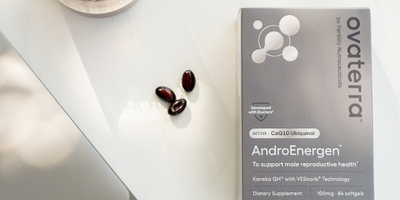Last updated: January 31, 2023
When women take DHEA (dehydroepiandrosterone) to support ovarian health and egg quality, doctors often monitor their hormone levels to see how well DHEA supplementation is working. One of the hormones monitored is DHEA-S, and reproductive health experts tend to pay more attention to DHEA-S than to DHEA in test results.
What’s the difference between DHEA and DHEA-S? And why does looking at the DHEA-S levels give us a better sense of our DHEA levels than testing for DHEA itself? Let’s find out.
But first, what is DHEA and what is DHEA-S?
DHEA is a weak androgen (male hormone) that both women and men have naturally in their body. DHEA is produced primarily in the zona reticularis of the adrenal gland, from cholesterol. In women, a small amount is produced by the ovaries, where it binds to androgen receptors and contributes to the healthy ovarian environment. DHEA is also produced by the brain, where it has been found to act on neurotransmitter and neurotrophin receptors.
DHEA-S, short for DHEA sulfate, is a sulfated form of DHEA – meaning that it has an extra sulfate molecule attached to DHEA. In contrast to DHEA, DHEA-S is almost exclusively produced in the adrenal cortex in women. When we take DHEA orally, DHEA is converted into DHEA-S in the liver and intestines and starts circulating in the body as DHEA-S.
DHEA-S is the “storage” form of DHEA
One important difference between DHEA and DHEA-S is their stability. DHEA’s half life is just 15-30 minutes, while DHEA-S is far more stable in the body, with a half life of up to 10 hours. Because of this difference, a vast majority of the DHEA we have in the body is actually in the form of DHEA-S. It’s the “circulating” or “storage” form of DHEA.
Tissues and organs that need DHEA, like the ovaries or the brain, take up DHEA-S from the blood and converts it back into DHEA to use as needed.
Why doctors track DHEA-S levels of women on DHEA
This explains why doctors track the DHEA-S levels of women who take DHEA supplements. Because it’s converted into DHEA-S almost immediately after we take DHEA, a blood test won’t pick up additional DHEA even in people who is consistently taking DHEA for reproductive health.
The increase in the supply of DHEA would show up in the DHEA-S levels instead. The two hormone levels are usually correlated, too, which makes measuring the effectiveness of DHEA supplementation through DHEA-S test easy. By measuring DHEA-S along with other hormone levels, doctors can tell if you are taking the right amount of DHEA for your ovarian health and adjust if necessary.
If you have any questions about DHEA vs. DHEA-S, please do reach out. We are with you.












